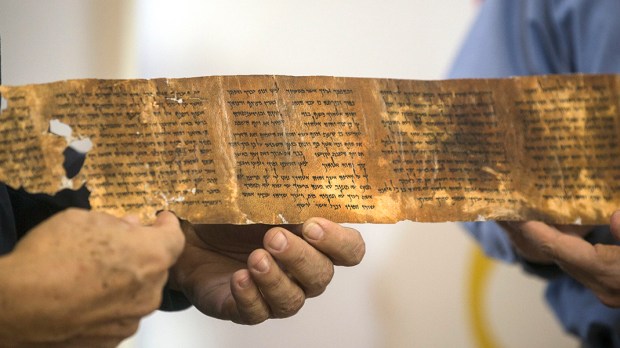For decades, scholars thought that the 60 tiny fragments discovered with the Dead Sea Scrolls came from different manuscripts.
Today, Israeli scholars announced that, over a half a century after the scrolls were discovered in the Qumran Caves near the Dead Sea, they have managed to put them together and decipher them.
Discovered between 1947 and 1956, the Dead Sea Scrolls are the oldest known copies of the Hebrew Bible, dating from the 3rd-century B.C. to the 1st-century A.D.
Dr. Eshbal Ratson and Prof. Jonathan Ben-Dov of the Department of Bible Studies at the University of Haifa spent over a year restoring and deciphering the manuscript, which was written in a secret code.
The documents are thought to have been created by members of a Judean desert sect that referred to itself as Yahad (“Together”) community. According to a statement by the scholars, they “were a fanatical group that lived a hermitic life in the desert and faced persecution by the dominant establishment of the time.”
Among the discoveries was the finding that the sect followed a 364-day calendar, rather than the lunar calendar:
“The lunar calendar, which Judaism follows to this day, requires a large number of human decisions. People must look at the stars and moon and report on their observations, and someone must be empowered to decide on the new month and the application of leap years. By contrast, the 364-day calendar was perfect. Because this number can be divided into four and seven, special occasions always fall on the same day. This avoids the need to decide, for example, what happens when a particular occasion falls on the Sabbath, as often happens in the lunar calendar. The Qumran calendar is unchanging, and it appears to have embodied the beliefs of the members of this community regarding perfection and holiness,” the researchers explain.
In addition, the scrolls describe two important holy days not mentioned in the Bible — the festivals of New Wine and New Oil.
While the manuscript was in code, the scholars note in a statement, there was no reason for secrecy, as the content was well known.
Another interesting note: the manuscript contained several edits in the margin.
It emerges that the person who wrote the scroll – probably one of the leaders of the sect familiar with the secret code – forgot to mention several special days marked by the community. Accordingly, another scribe was forced to correct the errors, adding the missing dates in the margins between the columns of text. “The scroll is written in code, but its actual content is simple and well-known, and there was no reason to conceal it. This practice is also found in many places outside the Land of Israel, where leaders write in secret code even when discussing universally-known matters, as a reflection of their status. The custom was intended to show that the author was familiar with the code, while others were not. However, this present scroll shows that the author made a number of mistakes,” the researchers note.
I

